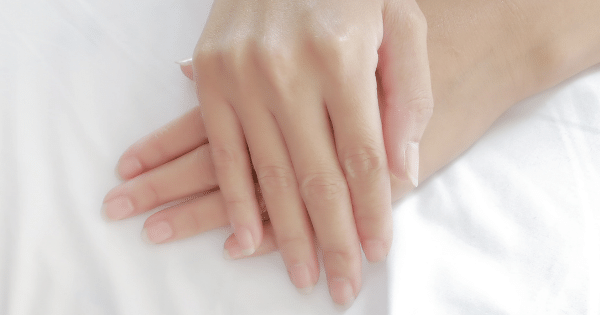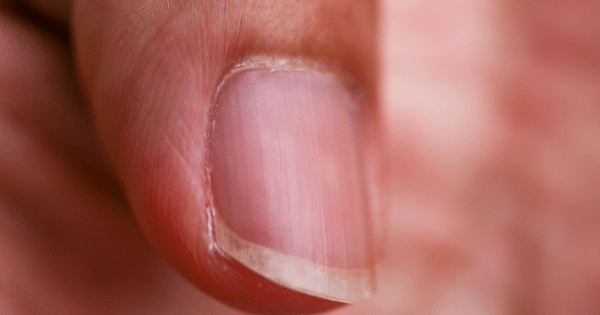Nails

Did you know that your nails can provide clues as to the general health of your body? It is possible that the white color or pink shade of your nails, some folds or bumps on the skin may indicate some health problems. The nails may reveal problems with the liver, lungs, and heart. Read on to discover what secrets your nails may hold.
Changes in nails
Do not ignore changes in your nails, but do not jump to conclusions either. A nail that is not smooth or of a different color can indicate a variety of diseases – or none at all. It is only your doctor who can provide you with an accurate diagnosis.
Consider the usual suspects before assuming that there is a serious problem. Nails crack, peel, or change color and texture due to bruises, under-the-nail bleeding, and fungal infections. Even though fungal infections are common, they can be difficult to treat. A dermatologist should be consulted if your symptoms do not resolve.
Changes in the nails are rarely the first indication of illness. There are usually other symptoms present before that occurs. As an example, emphysema can lead to breathing difficulties much earlier than significant changes on the nails.
White nails
Known as leukonychia, white nails refer to fingernails that are partially or completely white in color. Many factors can cause the white color, including trauma, anemia, dietary deficiencies, heart disease, kidney disease, and poisoning.
White nails with darker rims may indicate liver disease, such as hepatitis. You may have a low red blood cell count if your nails appear pale or white. Additionally, white nails may indicate liver disease, diabetes, an overactive thyroid, heart failure, or nutritional deficiencies.
The condition Terry’s nails is characterized by mostly white nails with a narrow pink band at the tip. As well as being a result of aging, it may also indicate the onset of diabetes, kidney, liver, or heart disease.→
Terry’s nails

Terry’s nails are characterized by white nails with a narrow pink band at the tip. The nails of Terry are a type of apparent leukonychia, which is characterized by ground glass opacification over nearly the entire nail, obliteration of the lunula, and a narrow band of normal, pink nail bed at the distal border. Besides normal aging, Terry’s nails can also indicate an underlying medical condition, including cirrhosis, chronic renal failure, and congestive heart failure.→
There is an opacification of nearly the entire nail, obliteration of the lunula, and a narrow band of normal, pink nail bed at the distal border. In addition to being a symptom of normal aging, Terry’s nails can also be a sign of an underlying medical condition. A thorough nail examination with every physical examination is important due to the association between nail changes and systemic disease.→
Yellow nails

Yellow nails are commonly caused by fungal infections. As the infection worsens, the nail bed may retract, and the nails may thicken and crumble. Rarely, yellow nails may indicate a more serious condition such as thyroid disease, lung disease, diabetes, or psoriasis.
The presence of thick, slow-growing and yellow nails can indicate lung diseases such as emphysema or chronic bronchitis. Yellow nail syndrome is also caused by fluid in your lungs and hands. Similarly, Raynaud’s phenomenon can occur when the fingers, toes, and nose do not receive adequate circulation.→
Yellow nails can even be caused by sinusitis (sinus inflammation), thyroid problems, lymph accumulation, and rheumatoid arthritis. In some cases, yellow nails run in families, suggesting a genetic link. You can only discover what they mean if you speak with your doctor.
Yellow nail syndrome
Yellow nail syndrome causes nails to thicken and new growth to slow down. As a result, the nails become yellowish in color. Yellow nail syndrome can cause nails to lack a cuticle and detach from the nail bed. In many cases, yellow nails are a sign of respiratory disease, such as chronic bronchitis. Lymphedema (swelling of the hands) can also cause yellow nail syndrome.→
Bluish nails
Blue nails can indicate low oxygen levels in the body. Emphysema, for example, could be causing this. Blue nails can also be a sign of heart problems.
A lack of oxygen in your blood causes your skin or membranes beneath your skin to turn a purplish-blue color. Cyanosis is the medical term for this type of appearance on the skin. Symptoms of cyanosis are blue-red-violet hues in the veins that are caused by deoxygenated blood coursing through the arteries.→
You might also notice it on your lips or earlobes. A lack of oxygen in your red blood cells can cause this. You will have your heart, lungs, blood cells, and blood vessels checked by your doctor. The first step in treating anemia is identifying the underlying cause. Unlike laboratory tests, cyanosis is a finding based on what is seen.→
Rippled nails
You have nail pitting when your fingernails or toenails have tiny dents. Psoriasis, eczema, and joint inflammation can cause it. A family history of these diseases might also make you susceptible to them.
Rippled or pitted nails may indicate psoriasis or inflammatory arthritis. The skin under the nail can appear reddish-brown when the nail is discolored.
The appearance of your toenails and fingernails is altered by nail psoriasis. Symptoms include thickening, pinprick holes, color changes, and shape changes. It is also possible for them to feel tender and painful.→
It’s possible that only your nails are affected, but it’s rare. That’s why pitting can be an indication that something is going on elsewhere in the body.
Cracked or split nails
Cracked or split nails, caused by dry, brittle nails, may be caused by thyroid disease. Fungal infections are more likely to cause cracking or splitting combined with a yellowish hue.
Cracked nails are commonly caused by getting older, something everyone goes through. Getting older makes your nails thinner and more likely to crack. Women over 60 are most likely to suffer from this, but men can also suffer from it.
Your fingernails can split if you spend a lot of time in and out of the water, such as when you wash dishes. Additionally, your body needs iron to produce healthy red blood cells that carry oxygen to all your tissues. Iron deficiency causes anemia. There are many symptoms of this condition, including cracked nails.
The risk of anemia increases during pregnancy. Ulcers and cancer, for example, can also cause these symptoms.
You may also see peeling and ridges if your cracked nails are related to aging. In addition, nail polishes and nail polish removers may contain strong chemicals. You might weaken and dry out your nails if you use them a lot. As a result, they are more likely to crack. Acryl nails can also cause a reaction due to glues and dyes.→
Nail products containing toluene and formaldehyde should be avoided. You might be able to heal your nails with biotin, a B vitamin supplement. Consult your doctor if your nails are still cracking after 6 months.
Puffy nail fold (Paronychia)
Inflammation, redness, tenderness, and swelling of the skin folds and tissues around the nails are symptoms of chronic paronychia. Usually caused by irritants or allergens, it can also be caused by the fungus Candida albicans, other infections, or psoriasis. It is possible for a bacterial infection to occur alongside a fungal infection.
Paronychia may develop slowly over a period of weeks or suddenly appear over a period of one or two days, depending on the cause. Paronychia’s symptoms are easily spotted and are usually easy and successful to treat with little or no damage to the skin or nails. If you don’t treat your infection, you may lose your nail partially or completely.→
Paronychia is a common condition. It can result from injury to the area, such as biting off or picking a hangnail, trimming or pushing back the cuticle. Topical steroids (corticosteroids) are usually effective in treating it.
Acute infections tend to occur around the fingernails and spread quickly. Biting, picking, hangnails, manicures, or other physical trauma can damage the skin around the nails. In the case of acute paronychia, Staphylococcus and Enterococcus bacteria are common infecting agents.
A chronic paronychia occurs slowly on fingers and toes. It usually lasts several weeks and comes back frequently. Typically, it is caused by several infecting agents, usually Candida yeast and bacteria. Those who work in water constantly are more likely to develop this condition. Wet skin causes the natural cuticle barrier to be disrupted for a long period of time. As a result, yeast and bacteria can grow and infect the skin.→
Dark lines beneath the nail
Melanonychia is a nail discoloration caused by the pigment melanin. A variety of causes may contribute to this condition, such as skin cancer, infection, or injury.
Nail trauma or fungal infections usually cause them. Infections in the heart lining can also cause them, as can psoriasis, or even melanoma. Under the fingernails or toenails, there are small areas of bleeding (hemorrhage).
Under the nails, splinter hemorrhages appear as thin, reddish-brown lines. The growth direction of the nails is the direction in which they run. Infection of the heart valves (endocarditis) can cause splinter hemorrhages. Vasculitis (swelling of the blood vessels) or microemboli (tiny clots that damage small capillaries) can cause them.→
Black or brown lines running from the bottom to the tip might be melanoma. It sometimes appears as a dark blob. The presence of cyanosis is not a symptom of all heart or lung diseases. Having no cyanosis may be reassuring, but it doesn’t mean there is no heart problem.
Gnawed nails
Occasionally, biting your nails may be nothing more than an old habit, but it could also indicate anxiety that needs treatment. The habit of biting or picking at one’s nails has also been linked to obsessive-compulsive disorder. Your doctor should be consulted if you are unable to stop.
It is common for people to bite their nails at some point in their lives, especially as children. Nail biting typically begins during childhood and increases during adolescence. This particular habit may not be clear why someone develops it, but once it begins, it can be difficult to control.
It is possible to bite the nail, the cuticle, and the tissue around the nail when you bite your nails. In most cases, nail biters don’t develop long-term damage, but it can happen. Generally, nail biting is a cosmetic problem that does not require medical attention. However, severe nail biting can lead to infections, dental issues, and other problems.→
Conclusion
Nail anomalies are frequently acompanied with hair or scalp problems. Its advised to have a preventive test of the pilosebaceous units of the scalp.
Despite the fact that changes in the nails occur with many health conditions, they are rarely the first sign of a health problem. There are many nail abnormalities that are harmless. Not everyone with white nails has hepatitis. Consult a dermatologist if you are concerned about the appearance of your nails.
Your doctor may be able to provide reassurance, or they may decide that further evaluation or consultation is needed.
Sources
https://www.ncbi.nlm.nih.gov/pmc/articles/PMC5448267/
https://www.webmd.com/skin-problems-and-treatments/ss/slideshow-nails-and-health
https://www.webmd.com/skin-problems-and-treatments/nails-look-weird
https://www.webmd.com/skin-problems-and-treatments/psoriasis/nail-psoriasis
https://www.mayoclinic.org/healthy-lifestyle/adult-health/multimedia/nails/sls-20076131
https://www.webmd.com/skin-problems-and-treatments/cracked-nails-reasons
https://www.healthline.com/health/why-do-people-bite-their-nails
https://medlineplus.gov/ency/article/003283.htm
https://medlineplus.gov/ency/article/001444.htm
https://www.hopkinsmedicine.org/health/conditions-and-diseases/other-bacterial-skin-infections
https://www.healthline.com/health/paronychia
